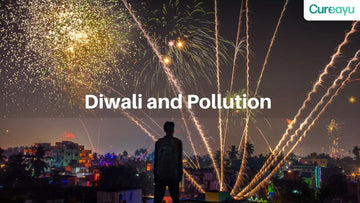Diwali, the festival of lights, is one of the most cherished celebrations across India and other parts of the world. Symbolizing the victory of light over darkness and good over evil, it brings families and communities together to celebrate with vibrant lights, fireworks, and festive delicacies. However, alongside the joy, there's a significant concern regarding pollution by Diwali that affects air quality, human health, and environmental balance. This blog explores the environmental impact of Diwali and offers insights on how to celebrate the festival responsibly, with reduced pollution.
How Diwali Celebrations Contribute to Pollution
Diwali's celebration often involves activities that release pollutants into the air, water, and soil. The most significant contributors are fireworks, which release high levels of smoke and chemicals, affecting air quality. Some other ways in which Diwali contributes to pollution include:
- Fireworks and Air Pollution: The large-scale use of fireworks releases harmful substances like sulfur dioxide, carbon monoxide, and heavy metals into the atmosphere, deteriorating air quality.
- Noise Pollution: Fireworks and loudspeakers create significant noise pollution, which affects animals, children, elderly, and those with sensitivities.
- Water Pollution from Rituals and Waste: Throwing ceremonial waste into rivers and lakes, along with post-celebration waste disposal, contributes to water pollution, affecting aquatic life.
- Soil Pollution Due to Firecracker Residue: The chemicals in firecracker remnants can seep into the soil, affecting its fertility and contributing to land pollution.
The Health Impact of Diwali Pollution
Pollution by Diwali has a notable impact on public health, particularly for those with respiratory illnesses. Each year, hospitals observe an increase in cases of asthma, bronchitis, and other breathing-related issues during Diwali due to:
- Respiratory Issues: Pollutants like sulfur dioxide and fine particulate matter can aggravate asthma and other respiratory conditions, especially in children and the elderly.
- Cardiovascular Problems: Studies have shown that short-term exposure to air pollution from fireworks can lead to heightened blood pressure and an increased risk of heart disease.
- Skin and Eye Irritation: Chemical pollutants and smog from fireworks can cause skin allergies, eye irritation, and worsen existing allergies.
Pollution Levels: Diwali's Impact on Air Quality Index (AQI)
During Diwali, there’s a significant spike in the Air Quality Index (AQI) across cities, especially metropolitan areas. The AQI readings during this period often reach "hazardous" levels due to the cumulative impact of:
- Fireworks: Fireworks release fine particulate matter (PM2.5 and PM10), which remains suspended in the air, drastically increasing pollution levels.
- Vehicular Emissions: Increased road traffic during Diwali adds to air pollution, as vehicles emit greenhouse gasses like carbon dioxide and nitrogen oxides.
- Lower Atmospheric Movement: Winter months often see lower wind speeds and temperature inversion, which causes pollutants to stay trapped near the ground, worsening air quality.
Environmental Effects of Pollution by Diwali
The environmental toll of Diwali pollution is alarming and affects the overall ecosystem in various ways:
- Impact on Wildlife: Loud noises from fireworks disturb animals, particularly birds and pets, who often face panic attacks and stress due to continuous sounds and lights.
- Damage to Flora: Firecracker residues settle on plants, affecting photosynthesis and the growth of vegetation, particularly in urban areas.
- Depletion of Natural Resources: The production of fireworks and increased use of non-biodegradable materials during Diwali celebrations lead to the depletion of resources like metals and chemicals, disrupting ecological balance.
Alternatives for a Cleaner and Greener Diwali
Switching to environmentally friendly practices during Diwali can help reduce pollution and preserve the essence of the festival. Here are some ways to celebrate responsibly:
- Eco-Friendly Fireworks: Consider using green crackers, which release lower amounts of harmful chemicals and reduce noise levels.
- Organic Rangolis: Instead of synthetic colors, use natural powders made from turmeric, henna, and flowers to create beautiful, eco-friendly rangolis.
- Clay Lamps Over LED Lights: Opt for traditional clay lamps instead of LED lights, which saves electricity and keeps the tradition alive.
- Biodegradable Decoration Materials: Instead of plastic decorations, use recyclable or biodegradable options like paper lanterns and cloth banners.
Why Green Crackers are a Better Choice
Green crackers have recently emerged as a viable alternative, as they produce less noise and lower emissions. They also contain fewer harmful chemicals and are designed to reduce particulate matter emissions by up to 30%. By choosing green crackers, we can enjoy fireworks with a minimal environmental impact.
Creating Awareness About Pollution by Diwali
Awareness campaigns on pollution during Diwali are essential for encouraging responsible celebration. Community-driven efforts can make a huge impact:
- School and College Awareness Programs: Educating children and youth about the harmful effects of firecrackers and pollution by Diwali can lead to behavioral changes.
- Social Media Campaigns: Platforms like Instagram, Twitter, and Facebook can spread awareness on responsible Diwali celebrations, reaching millions with eco-friendly tips and alternatives.
- Government and NGO Initiatives: Several organizations and local governments promote "Green Diwali" campaigns that encourage citizens to celebrate responsibly and follow pollution control guidelines.
Taking Personal Responsibility for a Clean Diwali
Each individual can make a difference by making conscious choices. Here are some practical ways to take responsibility:
- Limit Firework Usage: If you wish to light fireworks, limit the duration and quantity, focusing on eco-friendly options.
- Recycle Waste: Dispose of post-Diwali waste properly, separating recyclables and reducing landfill waste.
- Reduce Vehicle Usage: Avoid unnecessary trips and consider carpooling or using public transport to reduce emissions.
- Raise Awareness Among Neighbors and Family: Discuss the importance of pollution control with family and friends, encouraging them to adopt eco-friendly practices.
Conclusion
Diwali is a time of joy, unity, and gratitude, a festival where people come together to spread light and happiness. Yet, it is essential to balance our celebrations with responsibility toward the environment. The issue of pollution by Diwali is a collective concern, affecting not only human health but also our natural surroundings and the animals we coexist with. By choosing sustainable practices—like green fireworks, organic decorations, and reducing waste—we can preserve the spirit of Diwali while minimizing its environmental impact. Each step we take, however small, contributes to a cleaner, healthier world, ensuring that future generations can celebrate this festival with the same joy, but without the adverse effects of pollution. Let’s make this Diwali memorable not only for the lights and festivities but also for our efforts to protect the planet. Embrace a green Diwali this year and inspire others to do the same!








